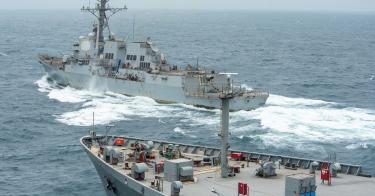Last month, within 24 hours—a magnitude 7.2 earthquake hit Haiti, and the Taliban seized Kabul. In both cases, the President turned to the Navy for offshore capabilities made possible only by large warships.
From this experience, one might conclude that the Navy should continue to focus on large ships, but that isn’t the full picture. Going forward, the U.S. will need a balance of both large and small warships, especially in the event of a major war with China.
The big ships were called upon to assist with the evacuation from Afghanistan. The Ronald Reagan carrier strike group had earlier been directed from East Asia to the Arabian Sea to provide air support. The repositioning was controversial at the time because it left East Asia without a single carrier strike group amidst heightened tensions between China and Taiwan and simmering disputes in the South China Sea.
Predictably it created an opportunity. Surprisingly, it was the Russians, not the Chinese, who exploited it.
In late June, the Russians sent naval and air forces to operate close to Hawaiian waters. Luckily the aircraft carrier Carl Vinson had shifted deployment training from Southern California to Hawaii, partially covering the gap opened by Reagan’s redeployment. This ability to quickly shift forces in response to adversary activity illustrates the importance and tradeoffs required by the limited number of aircraft carriers.
Then Kabul fell, and a natural disaster struck Haiti—on opposite ends of the world—adding urgency and complexity to the situation.
Yet, within a day, the Navy was executing humanitarian operations in Haiti while the operational tempo in Afghanistan rapidly escalated. In both, the ability to deploy and sustain long-range and heavy-lift aircraft was critical.
Off Haiti, the large amphibious ship Arlington with its provided medical assistance to more than 450 people and delivered 205,000 pounds of supplies. This operation helped the United States demonstrate its commitment to the region as well as its ability to provide aid quickly.
Meanwhile, warplanes from the Reagan and the large amphibious ship Iwo Jima had been providing air cover over Afghanistan for weeks in the Arabian Sea. As conditions rapidly deteriorated, the mission morphed to include moving military personnel in and out of Kabul, making room for evacuees on other aircraft. With the White House’s August 31 deadline fast approaching, the Navy began evacuating civilians, too, getting 3,000 people out.
The Navy’s ability to adapt to emergent missions and sustain operations for weeks at a time, all without the benefit of a base or host country, depends on large, capable ships. This is a point often glossed over when advocates press the Navy to shift to smaller but more numerous warships.
But as useful as big multipurpose ships are, they also take a long time to build. They're too few and too valuable to lose in a conflict with peer competitors such as China. For this reason the, Navy’s current strategy—Advantage at Sea—highlights that the Navy and Marine Corps rightly remain committed to Distributed Maritime Operations, investing in numerous light amphibious warships and unmanned platforms to lessen the impact of battle losses while presenting a multifaceted threat to our adversaries – such as optionally manned missile corvettes.
Moreover, the long construction times for big combatants—destroyers, aircraft carriers and large amphibious warships—mean the Navy will have to fight a future major war with however many large ships it has on Day One. Unmanned and smaller warships would have great value during a conflict due to their faster build and repair times. But pursuing a fleet design solely centered on smaller warships sacrifices the ability to conduct important missions such as those just executed off Haiti and in the Arabian Sea.
As the Navy looks to its future, it must get the balance right between capability (what’s carried), capacity (how much is carried), endurance (how long at sea), and survivability. Banking on a handful of large, irreplaceable warships puts all the fleet’s eggs in one, easier-to-target basket. On the other hand, an over-reliance on numerous smaller, limited, and less survivable warships risks operational irrelevance for enduring peacetime missions and sustained operations in contested waters.
Today, on both accounts—warships large and small—the Navy does not have the numbers needed to compete with China in peace and war, deter an opportunistic Russia, and respond to the unexpected.
A balanced fleet of large capable ships and more survivable smaller ships won’t be the cheapest option, but that isn’t the priority. Winning in war is.
This piece originally appeared in Real Clear Defense




